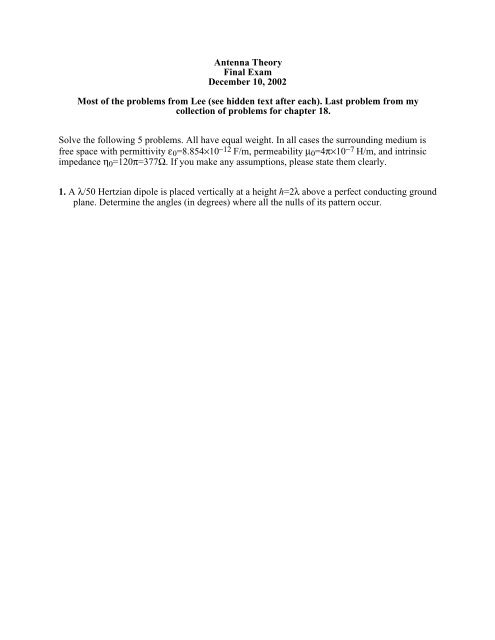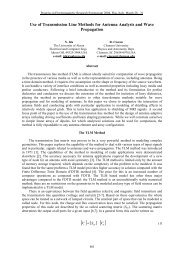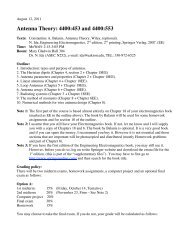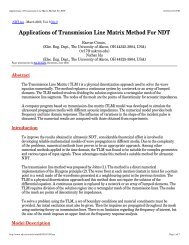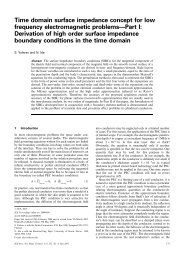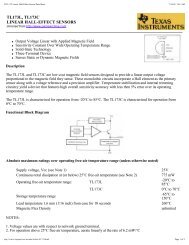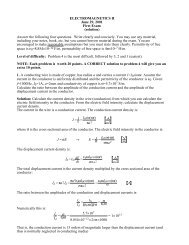You also want an ePaper? Increase the reach of your titles
YUMPU automatically turns print PDFs into web optimized ePapers that Google loves.
Antenna Theory<br />
<strong>Final</strong> Exam<br />
December 10, 2002<br />
Most of the problems from Lee (see hidden text after each). Last problem from my<br />
collection of problems for chapter 18.<br />
Solve the following 5 problems. All have equal weight. In all cases the surrounding medium is<br />
free space with permittivity ε 0 =8.854×10 −12 F/m, permeability µ 0 =4π×10 −7 H/m, and intrinsic<br />
impedance η 0 =120π=377Ω. If you make any assumptions, please state them clearly.<br />
1. A λ/50 Hertzian dipole is placed vertically at a height h=2λ above a perfect conducting ground<br />
plane. Determine the angles (in degrees) where all the nulls of its pattern occur.
2. Three isotropic sources with spacing d between them are placed along the z-axis. The<br />
excitation coefficient (i.e. the relative amplitude) of each outside element is unity while that<br />
of the center element is 2. For a spacing of d=λ/4 between the elements, find the<br />
(a) array factor<br />
(b) angles where the nulls of the pattern occur (0
3. The zeros of the array polynomial representing a four element linear array with the array axis<br />
along x are: z 1 = e jπ , z 2 = e jπ , z 3 = e jπ . The elements arc z-directed half-wave dipoles which<br />
interelement spacing of half-wavelength. The elements are excited in phase.<br />
(a) Find the relative current amplitudes of the four elements.<br />
(b) Find the mainbeam width (between nulls) of the array in degrees<br />
(c) If η=120π Ω and f=300 MHz, and the current amplitude of the first element of the array is 1<br />
mA rms, find the magnitude of the electric field |E| at a point with coordinates r =100 m,<br />
θ=90°, φ=90°
4. What is the total power radiated by an isotropic source in free space if |E|=1 mV/m at a<br />
distance of 10 km?
5. A dipole antenna is 1m long and is fed with a current of magnitude 2A.<br />
a. Find the radiated power of the antenna at 540 kHz (lowest AM frequency).<br />
b. Find the radiated power if operated at 1200 MHz (low microwave range).<br />
Solution: The radiated power may only be calculated if we know the type of antenna we have.<br />
For this we must first evaluate the wavelength and after that find the antenna radiation resistance.<br />
a. At 540 kHz:<br />
λ = c f = 3×10 8<br />
540×10 3 = 555.6 m<br />
The antenna is clearly a Hertzian dipole and we may use the radiation resistance in Eq. (18.59).<br />
With this we can write:<br />
b. At 88 MHz:<br />
P rad = I 0 2 R rad<br />
2<br />
= I 0 2 2 80π 2 ⎜ ⎛ ⎝<br />
∆l'<br />
λ<br />
⎟<br />
⎞<br />
⎠<br />
2<br />
= 2 2 2 ×80×π 2 × ( )<br />
1<br />
555.6<br />
λ = c f = 3×108<br />
88×10 6 = 3.41 m<br />
2 = 5.11 mw<br />
This antenna is not a Hertzian dipole because it is not short enough. It is not particularly long<br />
either so we will use the expression for the Hertzian dipole:<br />
c. At 180 MHz:<br />
P rad = I 0 2 R rad<br />
2<br />
= I 0 2 2 80π 2 ⎜ ⎛ ⎝<br />
∆l'<br />
λ<br />
⎟<br />
⎞<br />
⎠<br />
λ = c f = 3×10 8<br />
2<br />
= 2 2 2 ×80×π 2 × ( )<br />
1<br />
3.41<br />
180×10 6 = 1.667 m<br />
2 = 135.8 w<br />
This antenna is not a Hertzian dipole. In fact, forL=1m=0.6λ, β=2π/λ: and we must use the<br />
expression for arbitrarily long antennas:<br />
P rad = ηI 0 2<br />
θ=π<br />
4π∫ ( ( ) )<br />
θ=0<br />
2<br />
cos (βL/2)cosθ − cos(βL/2)<br />
dθ<br />
sinθ<br />
w<br />
From Eq. (18.139) and Table 18.2, the value of the integral above is:<br />
⌠<br />
⌡<br />
θ=π<br />
θ=0<br />
( ( ) )<br />
cos (βL/2)cosθ − cos(βL/2) 2<br />
sinθ<br />
dθ = 1.8535
The radiated power is therefore:<br />
d. At 1200 MHz:<br />
P rad = 1.8535 η 0I 0<br />
2<br />
4π = 1.8535×377×4<br />
4π<br />
= 222.43 w<br />
The radiated power is:<br />
λ = c f = 3×10 8<br />
= 0.25 m → L = 4λ<br />
1200×106 P rad = η 0I 0<br />
2<br />
4π ⌠ ⌡<br />
θ=π<br />
θ=0<br />
( ( ) )<br />
cos (4πcosθ − cos(4π) 2<br />
sinθ<br />
dθ = 3.5168η 0I 0<br />
2<br />
4π<br />
= 3.5168×377×4<br />
4π<br />
= 422<br />
w<br />
Note how much more power is radiated for the long antennas compared with the short dipole in<br />
(a).


